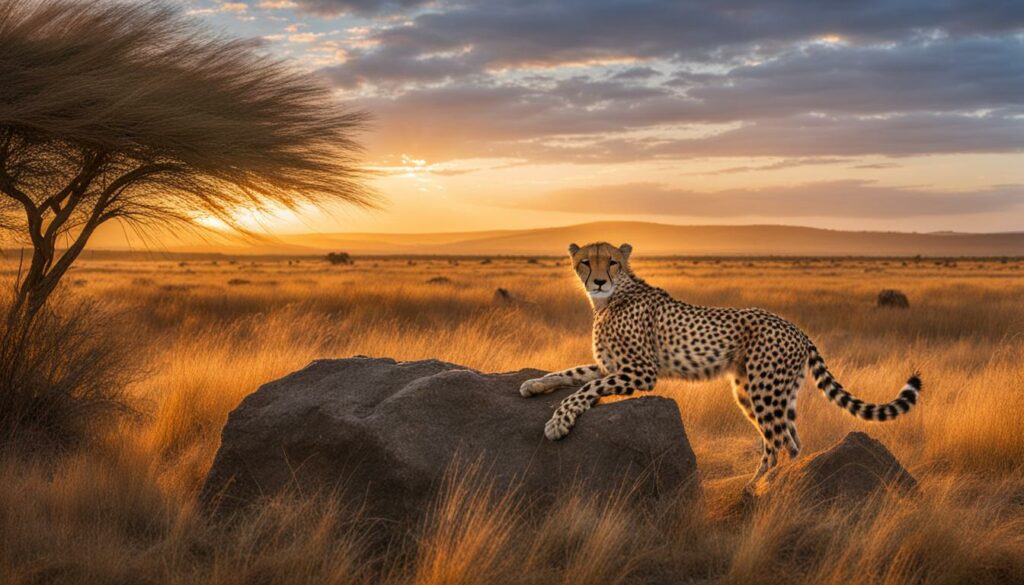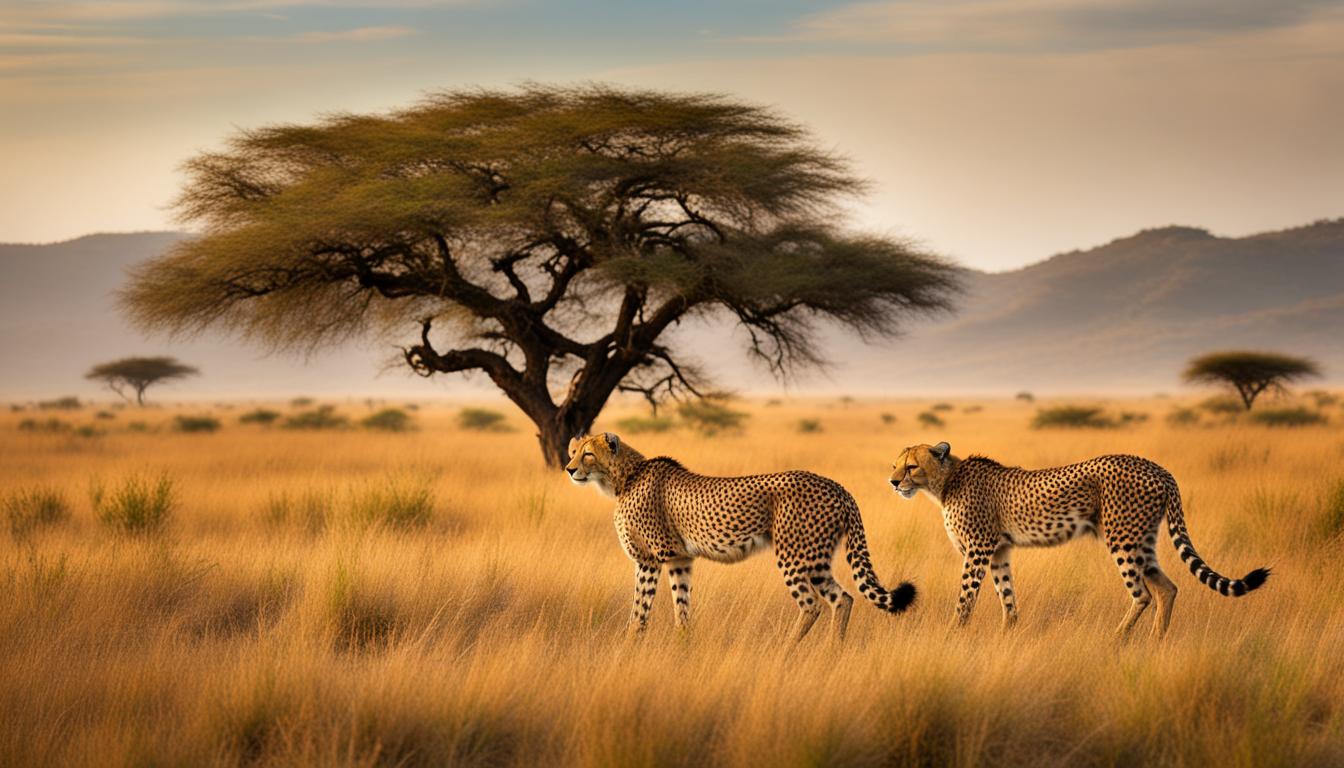If you’ve ever wondered about the majestic cheetah and its habitat, you’ve come to the right place. Cheetahs are fascinating creatures that reside in a variety of ecosystems across eastern and southern Africa. Their preferred habitat includes open grasslands and open plains, although they can adapt to other habitats as well. Cheetahs are native to Africa and central Iran, and they cannot be found in other parts of the world.
Now that you know where cheetahs can be found, let’s explore more about their habitat requirements and the threats they face.
Cheetah habitat requirements
Cheetahs have specific habitat requirements that are crucial for their survival. These requirements play a vital role in their ability to thrive in the wild. Understanding and protecting these requirements is essential for the conservation of cheetah populations.
One of the primary habitat requirements for cheetahs is the availability of large, connected areas to roam and hunt. Cheetahs are built for speed and require vast expanses of open grasslands and plains to reach their maximum running potential. These open spaces provide them with the opportunity to chase down their prey with incredible speed and agility.
In addition to space, cheetahs also rely on the availability of natural prey. They are specialized hunters, primarily targeting small to medium-sized ungulates such as gazelles and impalas. The presence of a healthy and abundant prey population is essential for cheetahs to meet their nutritional needs and ensure their long-term survival.
| Cheetah Habitat Requirements | Description |
|---|---|
| Large, connected habitat | Cheetahs require vast expanses of open grasslands and plains to roam and hunt. |
| Availability of natural prey | Cheetahs rely on a healthy and abundant prey population to meet their nutritional needs. |
| Protection from human activities | Conservation efforts are necessary to minimize habitat loss and human-cheetah conflicts. |
“The preservation and protection of cheetah habitat is crucial for the long-term survival of these magnificent creatures.” – Dr. Jane Wilson, Wildlife Conservationist
The Impact of Habitat Loss
Unfortunately, cheetahs face significant challenges due to habitat loss caused by human activities. As human populations expand and encroach upon natural habitats, cheetahs are losing their territories and access to prey. This loss of habitat not only limits their ability to find food but also increases the likelihood of conflicts with farmers as cheetahs search for alternative prey sources.
Conservation efforts are critical in preserving and protecting cheetah habitat. By creating wildlife parks and protected areas, we can provide the necessary space for cheetahs to thrive. Collaborating with local communities to find sustainable solutions that minimize human-cheetah conflicts is also essential. These efforts help ensure that both humans and cheetahs can coexist harmoniously, securing a future where cheetahs can roam freely in their natural environment.
In conclusion, cheetahs have specific habitat requirements, including large, connected areas to roam and hunt, and the availability of natural prey. However, these requirements are under threat due to human activities and habitat loss. It is crucial for conservation organizations, local communities, and individuals to come together to protect and preserve cheetah habitat. By doing so, we can ensure the long-term survival of these magnificent creatures and the ecosystems they call home.
Cheetah Habitat Threats
Cheetahs face numerous threats to their habitat, putting their survival at risk. One of the most significant threats is habitat loss and destruction due to human activities. As agriculture expands and urbanization increases, cheetahs lose their natural habitat, reducing their available living space and hunting grounds. This loss of habitat not only limits their ability to find food but also leads to increased competition for limited resources among cheetahs themselves.
Human activities also bring cheetahs into conflict with humans. As their habitat diminishes, cheetahs may venture into human settlements in search of food, leading to conflicts with farmers whose livestock they may prey upon. Additionally, the encroachment of human settlements on cheetah territory increases the risk of poaching as these magnificent creatures become more accessible targets for illegal wildlife trade and the exotic pet industry.
The threats to cheetah habitat are not only detrimental to the cheetah population but also have broader ecological implications. Cheetahs play a vital role in maintaining the balance of ecosystems by controlling prey populations. Their presence in the wild helps regulate the populations of herbivores, which in turn affects vegetation and overall ecosystem health. Therefore, the loss of cheetah habitat has far-reaching consequences that extend beyond the cheetah population itself.
Threats to Cheetah Habitat:
- Habitat loss and destruction due to human activities
- Increased competition for resources among cheetahs
- Conflicts with humans, particularly farmers
- Risk of poaching for illegal wildlife trade and exotic pet industry
- Ecological imbalance due to disruption of prey populations and vegetation
It is crucial to address these threats and take proactive measures to protect and preserve cheetah habitat. By promoting sustainable land use practices, implementing conservation strategies, and raising awareness about the importance of cheetahs and their habitat, we can contribute to the long-term survival and well-being of these remarkable creatures in the wild.
| Threats to Cheetah Habitat | Impact |
|---|---|
| Habitat loss and destruction | Reduces available living space and hunting grounds for cheetahs |
| Competition for resources | Increases competition among cheetahs, leading to potential conflicts and reduced food availability |
| Conflicts with humans | Puts cheetahs at risk of retaliation and can lead to loss of lives, both human and cheetah |
| Poaching for illegal wildlife trade and exotic pet industry | Threatens the survival of cheetahs and contributes to the decline of their population |
| Ecological imbalance | Disrupts prey populations and vegetation, impacting overall ecosystem health |
Cheetah Habitat Conservation
Preserving the habitat of cheetahs is crucial for the long-term survival of these magnificent animals. Conservation efforts are focused on creating protected areas and wildlife parks to ensure a safe environment for cheetahs to thrive. These protected habitats provide the necessary space for cheetahs to roam, hunt, and raise their young.
In addition to establishing protected areas, conservation organizations work closely with local communities to minimize human-cheetah conflicts. This involves providing agricultural training and incentives to help farmers implement practices that reduce potential conflicts with cheetahs. Measures are also taken to protect livestock from cheetah predation, ensuring that farmers do not view cheetahs as threats to their livelihoods.
By involving local communities in the conservation efforts, a sense of shared responsibility is fostered, leading to more sustainable solutions. It is essential to address the needs of both humans and cheetahs to find a balance that benefits both parties. Through these collaborative efforts, we can conserve cheetah habitat and create a harmonious coexistence between humans and these incredible animals.
Overall, conservation efforts for cheetah habitat preservation are vital to ensure the continued existence of cheetahs in the wild. By protecting their habitat and addressing the challenges they face, we can contribute to the long-term survival of these magnificent creatures.

The Importance of Collaboration
Collaboration is key in cheetah habitat conservation. It involves bringing together various stakeholders, including conservation organizations, local communities, and government authorities, to work towards a shared goal. By pooling resources, knowledge, and expertise, these collaborations can have a more significant impact on ensuring the preservation of cheetah habitat.
Conclusion
As you have learned, cheetahs are fascinating creatures that can be found in various habitats across Africa. They thrive in open grasslands and require large areas of connected habitat to roam and hunt freely. Unfortunately, their habitat is facing significant threats from human activities, resulting in habitat loss and destruction.
Preserving cheetah habitat is crucial for the survival of these magnificent animals. Conservation efforts play a vital role in protecting cheetahs and ensuring the long-term preservation of their habitat. This includes creating wildlife parks and protected areas, as well as working with local communities to find sustainable solutions that reduce human-cheetah conflicts.
By supporting these conservation initiatives, we can contribute to the preservation of cheetah habitat and secure a future where these incredible creatures continue to roam freely in their natural environment. Together, let us strive to protect cheetahs and their habitat, safeguarding their existence for generations to come.
How Do Cheetahs Protect Themselves from Natural Predators in the Wild?
Cheetahs protect themselves from natural predators of cheetahs by relying on their incredible speed and agility to outrun potential threats. They also use their keen eyesight to spot danger from afar, and their built-in camouflage helps them blend into their surroundings, making it easier to avoid being spotted by other predators.
FAQ
Where can cheetahs be found in the wild?
Cheetahs can be found in a range of habitats across eastern and southern Africa. They typically prefer open grasslands and open plains, but can also be found in other habitats. They are native to Africa and central Iran and are not found in other parts of the world.
What are the habitat requirements for cheetahs?
Cheetahs require large areas of connected habitat for their survival. They need space to roam and hunt. The availability of natural prey is also crucial for cheetahs.
What are the threats to cheetah habitat?
Cheetahs face threats to their habitat from habitat loss and destruction due to human activities such as agriculture, urbanization, and infrastructure development. This results in a decrease in the size of their natural habitat, increased competition for resources, and a higher risk of conflict with humans. Cheetahs are also threatened by the illegal wildlife trade and the exotic pet trade.
What are the conservation efforts for cheetah habitat preservation?
Conservation groups are actively working to protect cheetahs and their habitat. Efforts include creating wildlife parks and protected areas, working with local communities to find sustainable solutions that minimize human-cheetah conflicts, and implementing measures to protect livestock from cheetah predation.
Why is cheetah habitat preservation important?
Cheetah habitat preservation is important to ensure the survival of these incredible animals in the wild. By preserving cheetah habitat and addressing the challenges they face, we can contribute to the long-term survival of cheetahs and help secure a future where they can roam freely in their natural environment.











